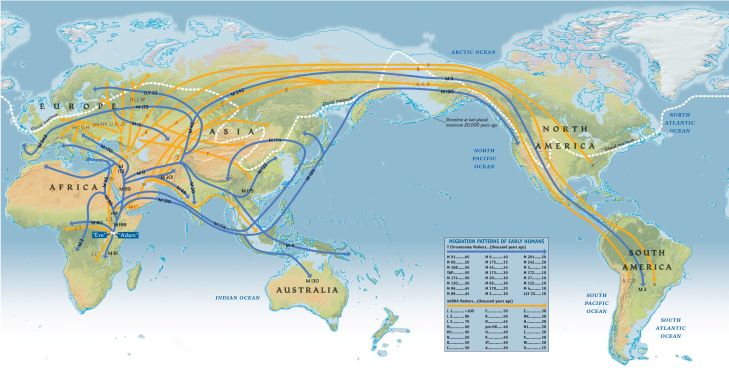HUMAN FAMILY TREE: National Geographic Project
LEARNING TARGETS:
- Understand how the human species has evolved over time.
- Give an example of a plant or animal adaptation that would confer a survival and reproductive advantage during a given environment change.
FOCUS QUESTIONS
1. What is the purpose of the Genographic Project?
To collect human DNA from people all over the world, and analyze those data to determine the various general pathways humans took out of Africa.
2. When and where did the first humans evolve?
Human beings evolved in Africa about 160,000 years ago, and lived only in Africa until around 60,000 years ago when we started to migrate, in little groups, in different directions
3. When did humans first start to immigrate to other parts of the Earth?
Around 60,000 years ago.
4. Where do we find evidence of early human migration patterns?
The traces of the migration patterns are found in modern DNA, passed down from mother to sons and daughters (called mitochondrial DNA) and from father to son (Y Chromosome DNA)—remember, women don’t have Y chromosomes.
5. What are some reasons given for the migration of early humans?
•Climate changes
•Food resources
•Fresh water sources
6. How old is the oldest DNA evidence?
•The oldest DNA evidence from mitochondrial DNA is Scientific Eve, some 160,000 years ago in Africa
•The oldest DNA evidence from Y Chromosome DNA is Scientific Adam, some 60,000 years ago also in Africa.
7. Explain what happened to the Neanderthals.
An ice age forced most Neanderthals to extinction.
The remaining Neanderthals were out-competed by Homo sapiens. Homo sapiens had higher intelligence which enabled them to control the natural resource that Neanderthals were competing for.
Neanderthals were pushed out of the Northern Eurasian climate where they were well adapted and ended up in Southern Europe. Being not well-adapted to the new region, Neanderthal populations dwindled until they eventually went extinct.
8. What roles has climate played in human migration?
•Around 70K-60K years ago, the climate turned extremely dry; humans almost go extinct.
•As climate warms up and becomes wetter, humans move out of Africa and can now migrate along coast lines in all directions.
•Newly exposed land bridges allow humans to travel great distances.
9. What do the DNA tests reveal about the genetic heritage of the people involved?
DNA tests reveal that all humans are related by a common ancestor that originated in Africa. DNA also provides evidence for genetic changes over time.


